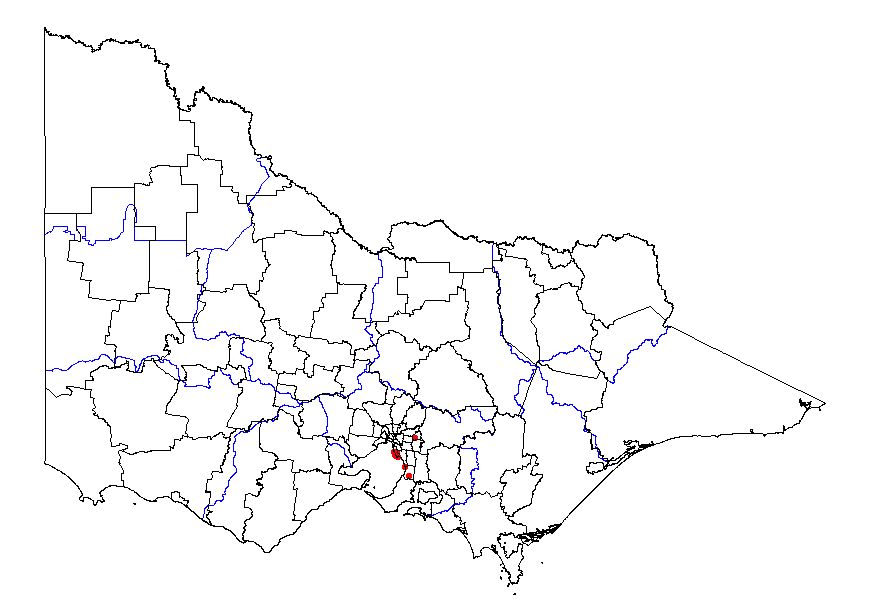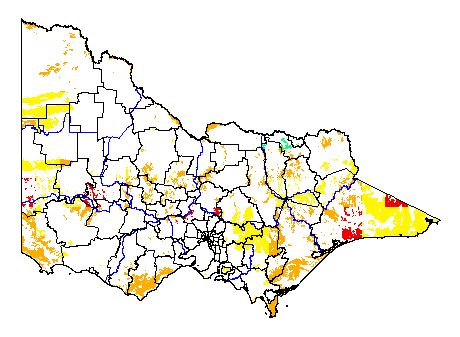Asparagus fern (Asparagus densiflorus)
Present distribution
|  Map showing the present distribution of this weed. | ||||
| Habitat: Native to South Africa. Warm temperate regions, growing within a temperature range of 10 to 20 C and rainfall from 500 to 1500mm annually. Ranges from coastal sand dunes to open woodland, especially where some shade is available (Parsons & Cuthbertson 2002). Dry to moist forests and openings. In Australia has invaded coastal, littoral rainforest, rainforest, frontal dunes and sclerophyll forest and coastal heath (Csurhes and Edwards, 1998). (DSE) 2004 | |||||
Potential distribution
Potential distribution produced from CLIMATE modelling refined by applying suitable landuse and vegetation type overlays with CMA boundaries
| Map Overlays Used Land Use: Forest private plantation; forest public plantation Broad vegetation types Coastal scrubs and grassland; coastal grassy woodland; heathy woodland; lowland forest; heath; swamp scrub; box ironbark forest; inland slopes woodland; sedge-rich woodland; moist foothills forest; montane moist forest; plains grassy woodland; valley grassy forest; herb-rich woodland; montane grassy woodland; riverine grassy woodland; riparian forest; rainshadow woodland; mallee heath; mallee woodland; wimmera/mallee woodland Colours indicate possibility of Asparagus densiflorusinfesting these areas. In the non-coloured areas the plant is unlikely to establish as the climate, soil or landuse is not presently suitable. | 
|
Impact
QUESTION | COMMENTS | RATING | CONFIDENCE |
| Social | |||
| 1. Restrict human access? | A much branched, spiny herb with stems 30 to 60cm long and well developed spines (Parsons & Cuthbertson 2002). Can occur in coastal sand dunes. May impede individual access. | ml | mh |
| 2. Reduce tourism? | Ornamental foliage (Parsons & Cuthbertson 2002). Can smother ground cover and occur in some recreational areas. Plant may have minor effect on aesthetics and inhibit some recreational activities. | ml | mh |
| 3. Injurious to people? | Plant has ‘well developed spines 5 to 10mm long’ (Parsons & Cuthbertson 2002). Berries can cause low toxicity if eaten. Skin irritation minor (PIER 2005). Spines at most times of the year. | mh | mh |
| 4. Damage to cultural sites? | Ornamental foliage and can smother ground cover (Parsons & Cuthbertson 2002). May have moderate visual effect if occurs at cultural sites. | ml | mh |
| Abiotic | |||
| 5. Impact flow? | Terrestrial species (Parsons & Cuthbertson 2002). | l | mh |
| 6. Impact water quality? | Terrestrial species (Parsons & Cuthbertson 2002). | l | mh |
| 7. Increase soil erosion? | Thick mat of tuberous roots. Plant doesn’t die back and leave bare soil exposed. (Parsons & Cuthbertson 2002). May help to bind soil. Low probability of large scale soil movement. | l | mh |
| 8. Reduce biomass? | ‘Smothers ground cover and can prevent regeneration of canopy species’ (Parsons & Cuthbertson 2002). Direct replacement of biomass by invader. | ml | mh |
| 9. Change fire regime? | The mass of underground organs completely suppresses other species (Parsons & Cuthbertson 2002). ‘Low growing shrub/ground cover of dry areas, might be flammable’ (PIER 2005). Insufficient evidence to determine whether plant may alter fire regime. | m | l |
| Community Habitat | |||
| 10. Impact on composition (a) high value EVC | EVC=Montane grassy woodland (BCS =V); CMA=East Gippsland; Bioreg=East Gippsland Uplands; CLIMATE potential=VH. ‘The mass of underground organs, together with the numerous seedlings produced, completely suppresses other species’ (Parsons & Cuthbertson 2002). Major displacement of some dominant spp. Within the lower strata. | mh | mh |
| (b) medium value EVC | EVC=Valley grassy forest (BCS =D); CMA=East Gippsland; Bioreg=East Gippsland Uplands; CLIMATE potential=VH. ‘The mass of underground organs, together with the numerous seedlings produced, completely suppresses other species’ (Parsons & Cuthbertson 2002). Major displacement of some dominant spp. Within the lower strata. | mh | mh |
| (c) low value EVC | EVC=Lowland forest (BCS =LC); CMA=East Gippsland; Bioreg=east Gippsland Uplands; CLIMATE potential=VH. ‘The mass of underground organs, together with the numerous seedlings produced, completely suppresses other species’ (Parsons & Cuthbertson 2002). Major displacement of some dominant spp. Within the lower strata. | mh | mh |
| 11. Impact on structure? | ‘The mass of underground organs, together with the numerous seedlings produced, completely suppresses other species’. Doesn’t establish in areas with dense cover of other low-growing plants (Parsons & Cuthbertson 2002). Major effect on lower strata. | mh | mh |
| 12. Effect on threatened flora? | Species not documented to have an additional effect on threatened flora. | mh | l |
| Fauna | |||
| 13. Effect on threatened fauna? | Species not documented to have an additional effect on threatened fauna. | mh | l |
| 14. Effect on non-threatened fauna? | ‘The mass of underground organs, together with the numerous seedlings produced, completely suppresses other species’ (Parsons & Cuthbertson 2002). Not documented although possible that the species may reduce habitat and food supply of non-threatened fauna. | ml | mh |
| 15. Benefits fauna? | Species not known to provide additional benefit to desirable fauna species. | h | mh |
| 16. Injurious to fauna? | Weed produces spines (Parsons & Cuthbertson 2002). May be injurious to fauna species. | mh | mh |
| Pest Animal | |||
| 17. Food source to pests? | Species not documented as a food source to pest species. | l | mh |
| 18. Provides harbor? | Species not documented as providing harbour to pest species. | l | mh |
| Agriculture | |||
| 19. Impact yield? | Not a weed of agriculture. | l | mh |
| 20. Impact quality? | Not a weed of agriculture. | l | mh |
| 21. Affect land value? | Weed not known to affect land value. | l | mh |
| 22. Change land use? | Weed not known to cause a change of priority of land use. | l | mh |
| 23. Increase harvest costs? | Not a weed of agriculture. | l | mh |
| 24. Disease host/vector? | Not a known host or vector for disease of agriculture. Other Asparagus species are susceptible to the rust fungus Fusarium oxysporum but A. densiflorus is resistant (ISSG 2006). | l | mh |
Invasive
QUESTION | COMMENTS | RATING | CONFIDENCE |
| Establishment | |||
| 1. Germination requirements? | May germinate any time of year if moisture is available (Parsons & Cuthbertson 2002). Opportunistic germinator. | h | mh |
| 2. Establishment requirements? | Shade-loving plant ‘grows best under a closed canopy of trees where the understorey species have been destroyed’ (Parsons & Cuthbertson 2002). Can establish under moderate canopy. | mh | mh |
| 3. How much disturbance is required? | Found in coastal dunes to open woodlands. Quickly invades disturbed sites (Parsons & Cuthbertson 2002). Establishes in minor disturbed natural ecosystems. | mh | mh |
| Growth/Competitive | |||
| 4. Life form? | Perennial herb. Trailing with underground tuberous roots (Parsons & Cuthbertson 2002). Life form – geophyte. | ml | mh |
| 5. Allelopathic properties? | None described. | l | mh |
| 6. Tolerates herb pressure? | The fruit and seed of several Asparagus spp.‘are damaged by an unidentified chalcid wasp and moth larva, while a rust fungus severely damages the fruit’. Under investigation for biocontrol (Parsons & Cuthbertson 2002). Weed may still persist. | ml | mh |
| 7. Normal growth rate? | Growth rate is slow until root system is well established then growth rapidly increases subsequently (Parsons & Cuthbertson 2002). Growth ‘rapid’ (UAPCCE 2004). Moderately rapid growth rate that will equal competitive species of the same life form. | mh | mh |
| 8. Stress tolerance to frost, drought, w/logg, sal. etc? | Grows in coastal sands (Parsons & Cuthbertson 2002). Slight tolerance to very light frost. Tolerates drought (ISSG 2006). Should not be overwatered (UAPCCE 2004). Maybe tolerant of fire as has underground tuberous roots. Tolerant to at least 2 and maybe tolerant of another. Susceptible to one. | mH | mh |
| Reproduction | |||
| 9. Reproductive system | Reproduces vegetatively and by seed (Parsons & Cuthbertson 2002). Both vegetative and sexual reproduction. | h | mh |
| 10. Number of propagules produced? | ‘Adult plants flower and fruit abundantly’ (Parsons & Cuthbertson 2002). PIER (2005) states ‘relatively large sized seed, few seeds per fruit’ less than 1000/m2. Insufficient information to determine number of propagules produced per flowering event. | m | l |
| 11. Propagule longevity? | Insufficient information to determine propagule longevity (PIER 2005). | m | l |
| 12. Reproductive period? | Can smother ground cover and reproduce vegetatively. No evidence that plant will form dense colonies (PIER 2005). Perennial herb. Likely to produce viable propagules for greater than 3 years. | mh | m |
| 13. Time to reproductive maturity? | ‘Although plants do not always flower in their first year ..’ (Parsons & Cuthbertson 2002). Indicates that plant may produce propagules between 1 – 2 years after germination. | mh | mh |
| Dispersal | |||
| 14. Number of mechanisms? | Spread through birds voiding the seeds (Parsons & Cuthbertson 2002). Bird dispersed | h | mh |
| 15. How far do they disperse? | Spread through birds voiding the seeds (Parsons & Cuthbertson 2002). Few propagules will disperse greater than 1 km but many will reach 200 – 1000m. | mh | mh |
References
Australian National Herbarium (ANH) 2006, Australia’s Virtual Herbarium, Australian National Herbarium, Centre for Plant Diversity and Research, viewed 21 Aug 2006, http://www.anbg.gov.au/avh/
Csurhes, S. & Edwards, R. 1998. Potential environmental weeds in Australia: Candidate species for preventative control, Canberra, Australia. Biodiversity Group, Environment Australia. 208 pp.
Global Biodiversity Information Facility (GBIF) 2006, Global biodiversity information facility: Prototype data portal, viewed 23 Aug 2006, http://www.gbif.org/
Invasive Species Specialist Group (ISSG) 2006, Global invasive species database, viewed 01 Sep 2006, http://www.issg.org/database/welcome/
Missouri Botanical Gardens (MBG) 2006, w3TROPICOS, Missouri Botanical Gardens Database, viewed 23 Aug 2006, http://mobot.mobot.org/W3T/Search/vast.html
Pacific Island Ecosystem at Risk (PIER) 2005, Risk Assessment: Asparagus densiflorus, Hawaii Ecosystem at Risk, viewed 30 Aug 2006, http://www.hear.org/Pier/wra/pacific/asparagus_densiflorus_htmlwra.htm
Parsons, W.T. & Cuthbertson, E.G. 2002, Noxious weeds of Australia, 2nd ed., CSIRO Publishing, Collingwood.
University of Arizona Pima County Cooperative Extension (UAPCCE) 2004, Asparagus densiflorus, University of Arizona Pima County Cooperative Extension, Master gardener Program, viewed 30 Aug 2006, http://cals.arizona.edu/pima/gardening/aridplants/Asparagus_densiflorus.html
Global present distribution data references
Australian National Herbarium (ANH) 2006, Australia’s Virtual Herbarium, Australian National Herbarium, Centre for Plant Diversity and Research, viewed 21 Aug 2006, http://www.anbg.gov.au/avh/
Esler, A.E. 1988, ‘Naturalisation of plants in Auckland – alien plants as weeds’, New Zealand Journal of Botany, vol. 26, pp. 585-618.
Global Biodiversity Information Facility (GBIF) 2006, Global biodiversity information facility: Prototype data portal, viewed 23 Aug 2006, http://www.gbif.org/
Invasive Species Specialist Group (ISSG) 2006, Global invasive species database, viewed 01 Sep 2006, http://www.issg.org/database/welcome/
Missouri Botanical Gardens (MBG) 2006, w3TROPICOS, Missouri Botanical Gardens Database, viewed 23 Aug 2006, http://mobot.mobot.org/W3T/Search/vast.html
Feedback
Do you have additional information about this plant that will improve the quality of the assessment?
If so, we would value your contribution. Click on the link to go to the feedback form.


